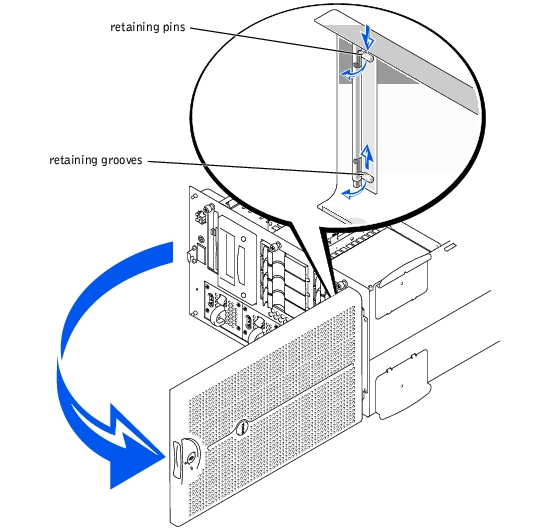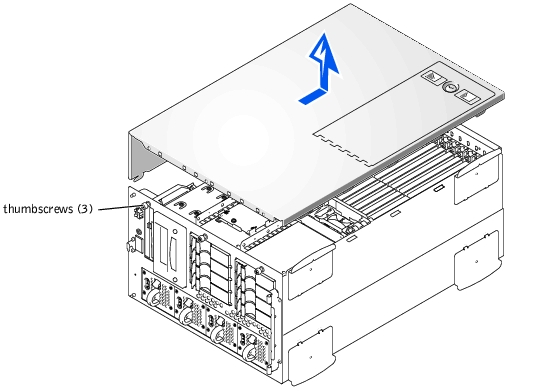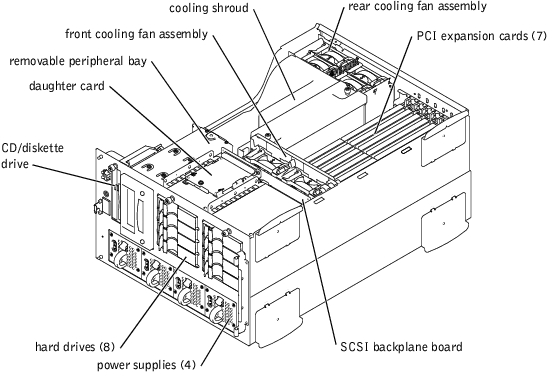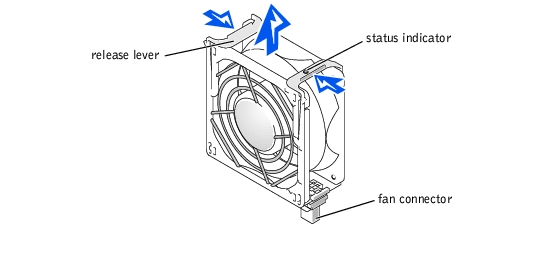 Safety First—For You and Your System
Safety First—For You and Your SystemDell™ PowerEdge™ 4600 Systems Installation and Troubleshooting Guide
 Safety First—For You and Your System
Safety First—For You and Your System
 Checking Specific System Problems
Checking Specific System Problems
 Removing and Replacing the Front Bezel
Removing and Replacing the Front Bezel
 Removing and Replacing the System Cover
Removing and Replacing the System Cover
 Responding to a System Management Alert Message
Responding to a System Management Alert Message
 Troubleshooting a Damaged System
Troubleshooting a Damaged System
 Troubleshooting the System Battery
Troubleshooting the System Battery
 Troubleshooting Redundant Power Supplies
Troubleshooting Redundant Power Supplies
 Troubleshooting Expansion Cards
Troubleshooting Expansion Cards
 Troubleshooting the System Board
Troubleshooting the System Board
 Troubleshooting the Diskette Drive
Troubleshooting the Diskette Drive
 Troubleshooting an External SCSI Tape Drive
Troubleshooting an External SCSI Tape Drive
 Troubleshooting an Integrated RAID Controller
Troubleshooting an Integrated RAID Controller
 Troubleshooting a RAID Controller Card
Troubleshooting a RAID Controller Card
If your system is not working as expected, begin troubleshooting using the procedures in this section. This section guides you through some initial checks and procedures that can solve basic system problems and provides troubleshooting procedures for components inside the system. Before you start any of the procedures in this section, take the following steps:
The procedures in this guide require that you remove the cover and work inside the system. While working inside the system, do not attempt to service the system except as explained in this guide and elsewhere in your system documentation. Always follow the instructions closely. Make sure to review all of the procedures in "Safety Instructions" in your System Information document.
Working inside the system is safe—if you observe the following precautions.

|
CAUTION: The power supplies in this system produce high voltages and energy hazards, which can cause bodily harm. Only trained service technicians are authorized to remove the system cover and access any of the components inside the system. |
 |
NOTICE: See "Protecting Against Electrostatic Discharge" in the safety instructions in your System Information document before performing any procedure which requires you to open the cover. |
Improperly set switches, controls, and loose or improperly connected cables are the most likely source of problems for the system, monitor, or other peripherals (such as a printer, keyboard, mouse, or other external equipment). A quick check of all the switches, controls, and cable connections can easily solve these problems. See Figure 2-3 for the back-panel features and connectors.
If it is not receiving power, plug it into another electrical outlet. If it still is not receiving power, try another PDU.
See "Troubleshooting the Video Subsystem."
See "Troubleshooting the Keyboard."
See "Troubleshooting the Basic I/O Functions."
Looking at and listening to the system is important in determining the source of a problem. Look and listen during the system's start-up routine for the indications described in Table 5-1.
|
Look/listen for: |
Action |
|---|---|
An error message | |
Alert messages from the Dell OpenManage™ Server Agent software | See "Alert Messages" in "Indicators, Messages, and Codes." |
The monitor's power indicator | |
The keyboard indicators | See "Troubleshooting the Keyboard." |
The diskette-drive access indicator | |
The hard-drive activity indicators | See "Troubleshooting Hard Drives." |
A series of beeps | |
An unfamiliar constant scraping or grinding sound when you access a drive | See "Getting Help" for instructions on obtaining technical assistance from Dell. |
Figure 5-1 shows the rack and tower versions of your system. The illustrations in this document are based on the tower version with the system laying on its side.
Figure 5-1. System Orientation

The front bezel has status indicators. Swinging the front bezel open provides access to the power switch, diskette drive, CD drive, hard drive(s), and power supplies. You must open or remove the front bezel and remove the system cover to gain access to internal components.
Figure 5-2. Removing the Front Bezel

 |
NOTE: The retaining pins are spring loaded. After rotating the pins downward and releasing the pins, they will automatically be inserted into the retaining hinge. You may need to move the bezel slightly to properly align the pins with the retaining hinge. |
The system is enclosed by a front bezel and a cover. To upgrade or troubleshoot the system, remove the system cover to gain access to internal components.
Figure 5-3. Removing the System Cover

This section provides troubleshooting procedures for equipment that connects directly to the I/O (back) panel of the system, such as the monitor, keyboard, or mouse. Before you perform any of the procedures, see "External Connections."
If the tests run successfully, the problem is not related to video hardware. Go to "Finding Software Solutions."
If the tests did not run successfully, see "Getting Help" for instructions on obtaining technical assistance.
If the keyboard and its cable appear to be free of physical damage and the keys work, go to step 4.
If the keyboard or its cable are damaged, continue to step 3.
If the problem is resolved, the keyboard must be replaced (see "Getting Help" for instructions on obtaining technical assistance).
If you can use the keyboard to select the keyboard test, go to step 6.
If you cannot use the keyboard to select the keyboard test, continue to step 5.
If the problem is resolved, the faulty keyboard must be replaced.
If the problem is not resolved, the keyboard controller on the system board is faulty (see "Getting Help" for instructions on obtaining technical assistance).
If the communications ports are set to Off, go to step 3.
If the communications ports are not set to Off, continue to step 2.
If the settings are correct, go to step 5.
If the test(s) did not run successfully, see "Getting Help" for instructions on obtaining technical assistance.
If the test(s) run successfully but the problem persists, see "Troubleshooting a Parallel Printer" or "Troubleshooting a Serial I/O Device," depending on the malfunctioning device.
If there is only one serial device connected to the system, go to step 5.
If the problem is resolved, the serial port may be defective (see "Getting Help" for instructions on obtaining technical assistance).
If the problem is resolved, the interface cable must be replaced (see "Getting Help" for instructions on obtaining technical assistance).
If the problem is resolved, the serial device must be replaced.
If the problem is not resolved, see "Getting Help" for instructions on obtaining technical assistance.
If the printer's self-test fails, see "Getting Help" for instructions on obtaining technical assistance.
If the self-test does not resolve the problem, continue to step 2.
If the print operation is successful, the interface cable must be replaced (see "Getting Help" for instructions on obtaining technical assistance).
If the print operation is not successful, replace the system board (see "Getting Help" for instructions on obtaining technical assistance).
If there is only one USB device connected to the system, go to step 6.
If the problem is resolved, the USB port may be defective (see "Getting Help" for instructions on obtaining technical assistance).
If the problem is resolved, the interface cable must be replaced (see "Getting Help" for instructions on obtaining technical assistance).
If the problem is resolved, the USB device must be replaced.
If the problem is not resolved, see "Getting Help" for instructions on obtaining technical assistance.
The green indicator shows that the adapter is connected to a valid link partner. The amber activity indicator is on if network data is being sent or received.

Check the drivers and remove and reinstall the drivers if applicable.
You must reboot your system for the reinstalled drivers to become active.
In Figure 5-5, the system cover and front bezel are removed to provide an interior view of the system.

The system board can accommodate up to seven PCI expansion cards (six PCI or PCI-X cards at 64-bit/33–100 MHz and one PCI card at 32-bit/33 MHz). The system memory is contained on two separate riser cards that must be populated with at least two memory modules each for the system to operate. The peripheral bay provides space for a 3.5-inch diskette drive, a CD drive, and two other devices (two hard drives or one tape drive).
The hard-drive bays provide space for up to eight 1-inch SCSI hard drives. These hard drives are connected to a SCSI host adapter on the system board or on an expansion card, via the SCSI backplane board.
The power distribution board (PDB) provides AC switching, hot-plug logic, and power distribution for the system. The system has two AC power inputs available to support AC power redundancy. The system can operate from either input and automatically switches from a failing AC source. Three hot-pluggable power supplies that are front-loadable and slide into connectors mounted on the PDB provide power to the system board, SCSI backplane board, and internal peripherals. There is an option for a fourth hot-pluggable power supply to provide redundant DC power.
For non-SCSI drives such as the diskette drive and CD drive, an interface cable connects the interposer board, attached to the diskette drive and CD drive, to the system board. For SCSI devices, interface cables connect externally accessible SCSI devices and the SCSI backplane board to a SCSI host adapter either on the system board or on an expansion card. For more information, see "Installing Drives."
During an installation or troubleshooting procedure, you may be required to change a jumper. For information on the system board jumpers, see "Jumpers and Connectors."
The optional system management applications monitor critical system voltages and temperatures, the system cooling fans, and the status of the SCSI hard drives in the system. Alert messages appear in the alert log window. For information about the alert log window and options, see your system management software documentation.
If the system does not start up properly, see "Getting Help" for instructions on obtaining technical assistance.
If the tests did not complete successfully, see "Getting Help" for instructions on obtaining technical assistance.
If the tests did not complete successfully, see "Getting Help" for instructions on obtaining technical assistance.
The system battery maintains system configuration, date, and time information in a special section of memory when you turn off the system. The operating life of the battery ranges from 2 to 5 years, depending on how you use the system (for example, if you keep the system on most of the time, the battery gets little use and thus lasts longer). You may need to replace the battery if an incorrect time or date is displayed during the boot routine.
You can operate the system without a battery; however, the system configuration information maintained by the battery in NVRAM is erased each time you remove power from the system. Therefore, you must reenter the system configuration information and reset the options each time the system boots until you replace the battery.
If the date and time are not correct in the System Setup program, replace the battery (see "System Battery").
If the problem is not resolved by replacing the battery, see "Getting Help" for instructions on obtaining technical assistance.
 |
NOTE: Some software may cause the system time to speed up or slow down. If the system seems to operate normally except for the time kept in the System Setup program, the problem may be caused by software rather than by a defective battery. |
 |
NOTE: If the system is turned off for long periods of time (for weeks or months), the NVRAM may lose its system configuration information. This situation is not caused by a defective battery. |
 |
NOTICE: The power supplies are hot-pluggable. The system requires three power supplies to be installed for the system to operate normally. The system is in the redundant mode when all four power supplies are installed. Remove and replace only one power supply at a time. |
 |
NOTE: There are two fan assemblies. The front fan assembly is located near the SCSI backplane board and contains two fans. The back panel fan assembly is attached to the back panel, memory riser card guides, and the cooling shroud. |
 |
NOTE: Each individual fan has a status indicator. If the fan is operating normally, the indicator is green. If the fan is malfunctioning, the indicator is amber. |
 |
NOTICE: The cooling fans are hot-pluggable. To maintain proper cooling while the system is on, replace only one fan at a time. |
Figure 5-6. Removing a Cooling Fan

 |
NOTE: After installing a new fan, allow up to 30 seconds for the system to recognize the fan and determine whether it is working properly. |
 |
NOTICE: If either the operating system or expansion card does not provide hot-plug support, you must power down the system before removing the expansion card. For more information, see the documentation for your operating system and the expansion card. |
 |
NOTE: Slot 1 is not a hot-pluggable connector. |
If the problem still exists, go to step 8.
If the tests do not complete successfully, see "Getting Help" for information on obtaining technical assistance.
If you have reinstalled all of the expansion cards and the Quick Tests are still failing, see "Getting Help" for information on obtaining technical assistance.
If there are no error messages, go to step 20.
 |
NOTICE: See "Protecting Against Electrostatic Discharge" in the safety instructions in your System Information document. |
If the amount of memory installed does not match the system memory setting, perform the following steps:
If the monitor screen remains blank and the Num Lock, Caps Lock, and Scroll Lock indicators on the keyboard remain on, perform the following steps:
If the monitor screen does not remain blank and the Num Lock, Caps Lock, and Scroll Lock indicators on the keyboard remain on, continue to step 20.
 |
NOTE: There are multiple configurations for the memory modules; see "Memory Module Installation Guidelines" in "Installing System Board Options." The following steps are an example of one configuration. |
If the problem is not resolved, see "Getting Help" for instructions on obtaining technical assistance.
If the test does not complete successfully, see "Getting Help" for instructions on obtaining technical assistance.
If the tests does not run successfully, see "Getting Help," for instructions on obtaining technical assistance.
If the tests does not complete successfully, see "Getting Help" for instructions on obtaining technical assistance.
If you have reinstalled all of the expansion cards and the problem still persists, see "Getting Help" for instructions on obtaining technical assistance.
If the test ran successfully, an expansion card may be conflicting with the diskette drive logic, or you may have a faulty expansion card. Continue to step 11.
If the test failed, see "Getting Help" for instructions on obtaining technical assistance.
If the problem is not resolved, see "Getting Help" for instructions on obtaining technical assistance.
If the problem is not resolved, see "Getting Help" for instructions on obtaining technical assistance.
For instructions on installing and configuring device drivers for the system's integrated SCSI host adapter, see "Using the Dell OpenManage Server Assistant CD" in the User's Guide.
For a SCSI host adapter card, see the documentation that accompanied the card.
See the documentation for the tape drive for instructions on selecting the SCSI ID and enabling or disabling termination.
If the problem is not resolved, see "Getting Help" for instructions on obtaining technical assistance.
 |
NOTICE: This troubleshooting procedure can destroy data stored on the hard drive. Before you proceed, back up all the files on the hard drive. |
 |
NOTE: If your system has an optional RAID controller installed, reboot the system and press <Ctrl><h>, <Ctrl><a>, or <Ctrl><m>, depending on the utility. See the documentation supplied with the controller for information on the configuration utility. |
If the hard drive functions properly in the original bay, the drive carrier could have intermittent problems. Replace the drive carrier (see "Installing SCSI Hard Drives").
If the drive carrier still does not function properly in the original bay, the SCSI backplane board has a defective connector (see "Getting Help" for instructions on obtaining technical assistance).
The SCSI cable may be connected to the internal SCSI host adapter on the system board or a SCSI host adapter card installed in an expansion slot.
 |
NOTE: To operate the SCSI backplane in a 1 x 8 configuration, make sure that a SCSI cable is connected only to the Channel A connector of the SCSI backplane and that a daughter card is not installed. To operate the SCSI backplane in a 2 x 4 configuration, make sure that both SCSI cables are connected and that a daughter card is installed. |
To partition and logically format the drive, see the operating system documentation.
If the problem is not resolved, see "Getting Help" for instructions on obtaining technical assistance.
If the controller is enabled, go to step 4.

|
CAUTION: Before you perform this procedure, you must turn off the system and disconnect it from its power source. For more information, see "Safety First—For You and Your System." |
 |
NOTICE: See "Protecting Against Electrostatic Discharge" in the safety instructions in your System Information document. |
See "Installing Memory Modules" in "Installing System Board Options" for general instructions on removing the RAID memory modules.
See Figure 6-1 for the location of the RAID hardware key.
If the problem is not resolved, see "Getting Help" for instructions on obtaining technical assistance.
Your system may contain an optional RAID controller card. If you encounter problems with the controller, see the RAID controller card's documentation for detailed information on troubleshooting.